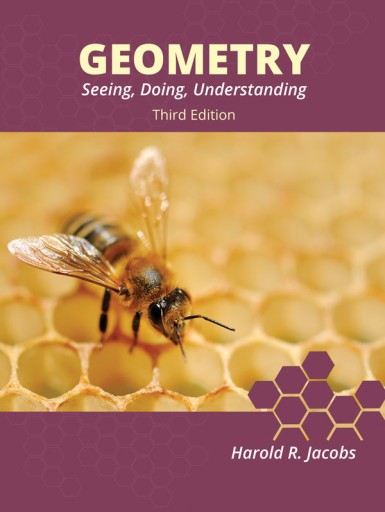With Geometry: Seeing, Doing, Understanding, Harold Jacobs has managed to write a user-friendly geometry text that is heavy on logic and proofs. This is one book where you don’t want to skip the introduction that fills students in on the influence of Euclid and teaches them the basics of construction with a straight edge and compass.
In the third edition (now published by Master Books), the first chapter is an introduction to vocabulary, tools, and basic ideas of geometry. This chapter ends with a lesson titled, “We Can’t Go On Like This,” a lesson that takes students through some intriguing problems to demonstrate the practical necessity for learning geometry along with a deeper understanding of why and how it works. For example, the first set of problems harkens back to ancient Egypt where three Egyptians purchase plots of land. The tax assessor is using a formula for the area of a quadrilateral that was used by the ancient Egyptians to determine the area of each plot for tax purposes. The rest of the problems have students determine the actual area of each plot, then compare that with the area determined by the assessor's formula. The final question in that section asks, "Which one of the three is cheated the most by the tax assessor's formula? Why?"
In the second chapter, Jacobs begins to teach deductive reasoning. Many people cite the value of geometry as being the development of logical thinking skills. Jacobs takes this idea seriously, ensuring that students are truly tuned in to logical thinking before tackling other geometry topics. Given the foundation in logic, students then immediately begin work with proofs which continues throughout the text.
Jacobs uses entertaining illustrations (including cartoons), as well as practical applications and engaging word problems. For example, the lesson on similar figures and ratio begins with a comparison of movie and television screens, including the letterbox option that changes the ratio.
The topic arrangement is different than I have seen in most texts. For instance, work with circles follows introductory lessons on trigonometry. The trigonometry is introduced as a natural progression in the study of triangles rather than as an entirely separate topic. Even if the arrangement is unusual, there is a clear continuity to topics, building one upon another.
There are sixteen chapters in the hardcover textbook, with each chapter divided into a number of lessons. Each lesson has three problem sets, and all students should try to complete the first two sets. The third set frequently features interesting investigations, but these should be used as a challenge for better students who have the time. A summary and review at the end of each chapter includes a specific section labeled "algebra review." This helpful feature should help students retain what they learned from their first algebra course. While at least one exercise requires the use of a calculator, for the most part, this course does not require a graphing calculator.
Construction activities (using straightedge and compass) are minimal. Because of this and the emphasis on logic, I recommend this text for abstract thinkers rather than hands-on learners. But I suspect that even some students who struggle with the logic will like this text because the presentation is so appealing.
Problems from old SAT tests are interspersed throughout the exercises. They are labeled as such, but students need to be aware that these problems are not from current versions of the tests.
Selected answers for about one-fourth to one-third of the problems from each lesson (selected in no numerical sequence) are at the back of the student text. All answers are in the teacher guide. A separate solutions manual with worked out answers for all problems is optional, but I recommend that you get it.
While students can work through the text on their own or with a teacher, an optional set of DVDs feature Dr. Callahan teaching lessons and working through examples. This set of five DVDs runs a total of about four hours.
The student textbook and the teacher guide are the most critical components, but if you want the solutions manual or DVDs, you should purchase either the curriculum pack with the textbook, teacher guide, and solutions manual or the curriculum pack that also includes the set of DVDs.











